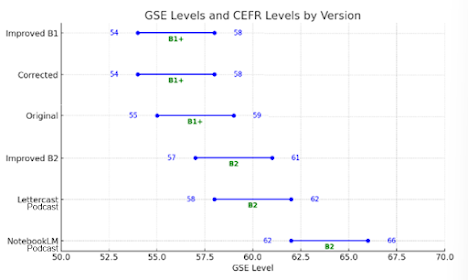|
Sources |
NotebookLM |
Lettercast.ai |
NotebookLM
greater by |
|
Iconic
British Designs: The London Tube Map and the London Eye |
218 seconds |
153 seconds |
42% |
|
https://notebooklm.google.com/notebook/7e91a45e-e544-4447-98b3-e19889f99463
|
https://app.lettercast.ai/casts/0f2bd232-b44a-4983-af32-f6f4e559c66d.mp3 |
|
|
|
647 words |
375 words |
72% |
|
|
178 wpm |
147 wpm |
21% |
|
|
GSE
level: 62 - 66 |
GSE
level: 58 - 62 |
7% |
|
|
CEFR
level: B2 |
CEFR level: B2 |
= |
|
|
Social rules
in my country |
314 seconds |
129 seconds |
143% |
|
https://notebooklm.google.com/notebook/d6ec3dd2-cb55-4087-b228-20e0b6de8525
|
https://app.lettercast.ai/casts/b5fae50f-80f1-4376-97ea-bb515483db56.mp3
|
|
|
|
947 words |
310 words |
205% |
|
|
180 wpm |
144 wpm |
25% |
|
|
GSE
level: 64 - 68 |
GSE
level: 55 - 59 |
16% |
|
|
CEFR
level: B2 |
CEFR
level: B1+ |
+ |
|
|
Eat and drink
– at the right time! |
252 seconds |
172 seconds |
47% |
|
https://notebooklm.google.com/notebook/af091734-070b-464c-b5b5-64617d0a355c
|
https://app.lettercast.ai/casts/450f171b-b2fe-4d85-8c6c-e1e4fa3e57f4.mp3
|
|
|
|
797 words |
405 words |
|
|
|
190 wpm |
141 wpm |
97% |
|
|
GSE
level: 62 - 66 |
GSE
level: 62 - 66 |
35% |
|
|
CEFR
level: B2 |
CEFR level: B2 |
= |
|
|
Spanish
honeymoon couple on the Titanic |
267 seconds |
126 seconds |
112% |
|
https://notebooklm.google.com/notebook/39bc7cb2-54e4-407e-a6cd-24c031f7350c |
https://app.lettercast.ai/casts/7f3bf733-92c1-46d3-9773-c9276b5940c1.mp3
|
|
|
|
823 words |
309 words |
166% |
|
|
185 wpm |
147 wpm |
26% |
|
|
GSE
level: 57 - 61 |
GSE
level: 62 - 66 |
-8% |
|
|
CEFR
level: B2 |
CEFR
level: B2 |
= |
|
|
Averages |
263 seconds |
145 seconds |
81% |
|
804 words |
350 words |
130% |
|
|
183 words per
minute |
145 words per
minute |
26% |
|
|
GSE level 63 |
GSE level 61 |
3% |
|
|
CEFR level B2 |
CEFR level B2 |
= |
There are some major differences between these two ways of
generating podcasts. NotebookLM is much faster and the interface is much more
sophisticated and it’s much easier to share the recordings. What’s more
Lettercast only accepts PDF files as sources. NotebookLM even lets you upload audio
files now!
The podcasts produced by NotebookLM are 81% longer on
average and 26% faster, which means that the number of words is more than
double (130% more). The levels on the GSE and CEFR scales are very similar (B2)
and suitable for students at B1 and up, but not lower.
The major problem
with the NotebookLM podcasts is that they are very fast: 183 words per
minute. NotebookLM allows you to play them at 80% which means the speed would
be about 146 wpm, much the same as Lettercast. Sadly, Lettercast only allows
you to play the podcast faster!
My suggestion is to use Turboscribe.ai to get a transcript
of the podcasts which can then be listened to with the script highlighted section
by section, although you have to move the page up all the time.
From NotebookLM you can download the .wav file and then
upload it to Turboscribe, specify that there are two speakers and click on
TRANSCRIBE. You can change the speed to 75%, which will reduce the speed to
about 137 words per minute.
From Lettercast.ai It is more complicated. You need to click on View all and then on the orange RSS feed icon, find the link to the audio file which is an .mp3 file select it and select Copy and paste the link into Turboscribe, specify that there are two speakers and click on TRANSCRIBE.
A further problem with Lettercast.ai is that now I have made
5 podcasts, I don’t seem to be able to make any more on my free account
although it specifies 20 free podcasts per month.










